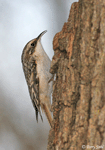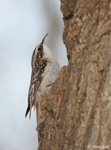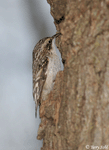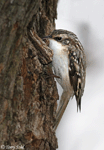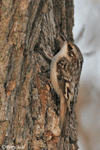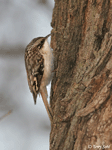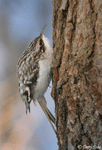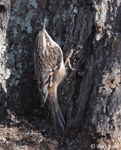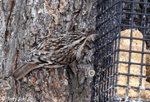| Length: 5 inches | Wingspan: 7 inches | Seasonality: Winter / All Seasons |
| ID Keys: Streaked brown upperparts, white underparts, white eyebrow, thin curved bill | ||
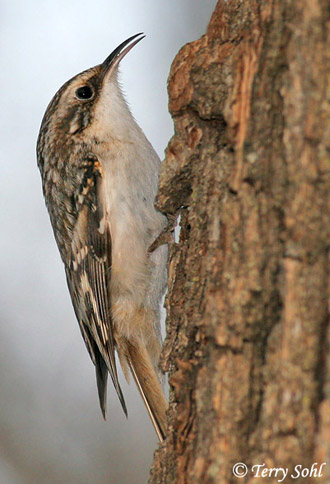 The Brown Creeper is best known for it's
very active foraging
behavior of flying to the base of a tree, spiraling upwards in search of food,
and then flying to the base of another tree to begin the process again. In
addition to constantly scouring crevices in tree bark for food, they also
build their nests under flaps of loose bark. In the
winter, Brown Creepers can often be found in mixed flocks with Chickadees and
Nuthatches.
The Brown Creeper is best known for it's
very active foraging
behavior of flying to the base of a tree, spiraling upwards in search of food,
and then flying to the base of another tree to begin the process again. In
addition to constantly scouring crevices in tree bark for food, they also
build their nests under flaps of loose bark. In the
winter, Brown Creepers can often be found in mixed flocks with Chickadees and
Nuthatches.
Habitat: Prefers mature forest for breeding, but can be found in parks and residential areas during winter and migration.
Diet: Mostly insects. Will occasionally eat seeds, and will visit feeders in the winter.
Behavior: The vast majority of its foraging is done by climbing on tree trunks or major branches, probing crevices for insects and insect eggs.
Nesting: May through July
Song: Brown Creeper Song
Migration: Brown Creepers are permanent residents in much of their normal range in Canada, the Northeast U.S., the Great Lakes area, the Appalachians, and the mountains of the west. Some birds do migrate southward in the winter however, where they also spill out into forested habitats across the U.S.
Interactive eBird Map: Click to access an interactive eBird map of Brown Creeper sightings
Similar Species: Generally distinctive in look and habit, not likely to be confused with other small songbirds.
Bird Feeders: Will attend feeders for suet, peanuts, and peanut butter.
Conservation Status: Due to its preference for mature forest for breeding, they have declined in many parts of their range. Still relatively common and widespread however.
Further Information: 1) USGS Patuxent Bird Identification InfoCenter, Brown Creeper
3) Audubon Guide - Brown Creeper
Photo Information: November 13th, 2008 - Big Sioux Recreation Area near Brandon, South Dakota.
Additional Photos: Click on the image chips or text links below for additional, higher-resolution Brown Creeper photos.
| Click on the map below for a higher-resolution view |
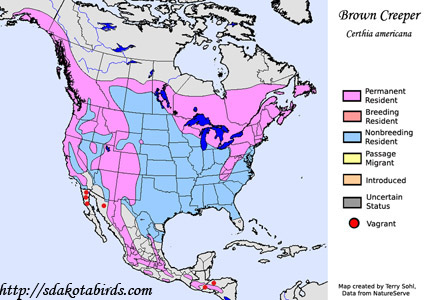 |
| South Dakota Status: Uncommon migrant and winter resident. Uncommon permanent resident in the Black Hills. |
Additional Brown Creeper Photos
Click for a higher-resolution version of these photos
